Analysis of Post-Mining Vegetation Development Using Remote Sensing and Spatial Regression Approach: A Case Study of Former Babina Mine (Western Poland)
Abstract
1. Introduction
- spatiotemporal description of the vegetation condition trajectory in the 1989–2019 period;
- identification of sites with significant flora changes;
- testing GIS-based methodology to analyze the relationship between the condition of vegetation and the potential topographical and mining driving factors.
2. Study Area
3. Materials and Methods
3.1. Geospatial Data
- 67 archival geological and mining maps were drawn at the 1:1000 scale between 1956–1973, obtained from the State Mining Authority and listed in Table S1 (Supplementary Materials);
- vector data from the Database of Topographical Objects (scale 1: 10,000) representing the location of water reservoirs in the research area and available from [54];
- Digital Elevation Model (DEM) (1 m resolution) obtained from aerial laser scanning performed in 2020 and available from [55];
- German Topographical Map—Messtischblatt drawn at the 1:25,000 scale and representing the study area as it was in 1911;
- vector data representing the extent of the glaciotectonic structures and documented locations of gizers in the area, developed by [56];
- vector data representing boundaries of mineral deposits in Poland available from [57];
- Hydrogeological Map of Poland from the year 2006 and drawn at scale 1:50,000 [58];
- archival meteorological data (precipitation and air temperature) for the 1989–2019 period (corresponding to the months of satellite imagery acquisitions), obtained from [59].
3.2. Pre-Processing of Satellite Data
- the average terrain height of the former mining field (100 m a.s.l.);
- atmosphere model—in this study, based on the image registration date, models with a water vapor content of 2.08 or 2.92 and an average air temperature of 14 or 21 °C were used (Sub-Arctic Summer and Mid-Latitude Summer models, respectively);
- aerosol model—in the analyzed case, a model dedicated to a slightly polluted and non-urbanized areas was selected.
3.3. Remote Sensing Vegetation Indices
- Normalized Difference Vegetation Index (NDVI)—that is a combination of red and near-infrared bands, the spectral ranges in which the highest absorption and reflection of solar radiation by vegetation are observed, respectively [62]. This index enables the identification of flora among other forms of land cover and the general assessment of its condition and is given by the formula (2):where: NIR and RED are the spectral reflectance values in the near-infrared and red bands, respectively [17].
- 2.
- Normalized Difference Infrared Index (NDII)—developed by Hardisky et al. [64] using the reflectance value in the near and short infrared bands. NDII enables to assess the water content of vegetation, and it is given by the formula (3):where: SWIR1 is the spectral reflectance value in the short infrared band.
- 3.
- Modified Triangular Vegetation Index—Improved (MTVI2)—spectral bands combination developed by Haboudane et al. [67], used for the estimation of leaf area index (LAI), with the following formula (4):where: , and are the spectral reflectance values for the wavelengths of 800 nm, 550 nm, and 670 nm, respectively.
3.4. Spatial Statistics and Multivariate Weighted Spatial Regression
- mining factors: number of shafts per reference unit area, average and minimum depth of the underground excavations, the average depth of the mining shafts, distance from former open pits, distance from the underground workings, distance from the mining waste heaps, area of the underground mining excavations per reference unit area;
- geological factors: distance from lignite seams, distance from gizers, groundwater table elevation, distance from the boundary of glaciotectonic changes;
- topographic factors: DEM (as in the year 2020), DEM (as in the year 1911), DEM of Difference (2020–1911), slope and aspect of the terrain, and distance from the anthropogenic lakes.
4. Results
4.1. Vegetation General Condition in the 1989–2019 Period
4.2. Statistical Analysis of Dependent Variables
4.3. Independent Variables
4.3.1. Mining Factors
4.3.2. Geological Factors
4.3.3. Topographic Factors
4.4. Correlation Analysis of Independent Variables
4.5. Multivariate Weighted Spatial Regression Models
- the northwestern, northeastern, eastern, southeastern, and southwestern parts of test field no. 4;
- the northwestern part of test field no. 1;
- the northeastern, southwestern, southeastern and southern parts of test field no. 3.
5. Discussion
6. Conclusions
Supplementary Materials
Author Contributions
Funding
Data Availability Statement
Acknowledgments
Conflicts of Interest
Appendix A
| Mission | Sensor Name | Duration of Mission | Number of Spectral Bands | Spectral Range [µm] | Spatial Resolution [m] | Date of the Acquired Image |
|---|---|---|---|---|---|---|
| Landsat 5 | Thematic Mapper (TM) | 03.1984–06.2013 | 7 | 0.45–12.5 | visible light, infrared bands: 30 m thermal band: 120 m | 18.09.1989, 04.08.1990, 07.08.1991, 10.09.1992, 08.05.1993, 31.08.1994, 18.08.1995, 20.08.1996, 01.09.1997, 10.08.1998, 14.09.1999, 11.05.2000, 14.05.2001, 18.06.2002, 25.09.2003, 10.08.2004, 29.08.2005, 26.09.2006, 19.08.2007, 29.07.2008, 24.08.2009, 12.09.2010, 24.09.2011 |
| Landsat 7 | Enhanced Thematic Mapper Plus (ETM+) | 04.1999–at present | 8 | 0.45–12.5 | visible light, infrared bands: 30 m thermal band: 60 m panchromatic band: 15 m | 20.05.2012 |
| Landsat 8 | Operational Land Imager (OLI) | 02.2013—at present | 11 | 0.43—12.5 | visible light, infrared bands: 30 m panchromatic band: 15 m thermal bands: 100 m | 15.05.2013, 07.09.2014, 19.09.2015, 12.09.2016, 30.08.2017, 17.08.2018, 21.09.2019 |
Appendix B
| Parameter | OLS Model | ||
|---|---|---|---|
| NDVI | NDII | MTVI2 | |
| adj | 0.23 | 0.19 | 0.18 |
| AICc | 641.2 | −5879.9 | −16,490.1 |
| Joint Wald statistics | 1053.6 * | 963.3 * | 1761.9 * |
| Koenker statistics | 1100.9 * | 1118.0 * | 598.4 * |
| Global Moran I statistics | 98.6 * | 88.6 * | 94.3 * |
References
- Kaszowska, O. The impact of underground mining on the ground surface. Probl. Ecol. 2007, 11, 52–57. (In Polish) [Google Scholar]
- Motyka, J.; Czop, M.; Jończyk, W.; Stachowicz, Z.; Jończyk, I.; Martyniak, R. he impact of deep lignite mining on changes in the water environment in the area of the “Bełchatów” mine. Min. Geoengin. 2007, 31, 477–487. (In Polish) [Google Scholar]
- Bednorz, J. Socio-ecological effects of hard coal mining in Poland. Min. Geol. 2011, 6, 5–17. (In Polish) [Google Scholar]
- Lapčik, V.; Lapčiková, M. Environmental Impact Assessment of Surface Mining. J. Pol. Miner. Eng. Soc. 2011, 1, 1–10. [Google Scholar]
- Kretschmann, J.; Nguyen, N. Research Areas in Post-Mining—Experiences from German Hard Coal Mining. Inżynieria Miner. 2020, 1, 255–262. [Google Scholar] [CrossRef]
- Vervoort, A.; Declercq, P.-Y. Surface Movement above Old Coal Longwalls after Mine Closure. Int. J. Min. Sci. Technol. 2017, 27, 481–490. [Google Scholar] [CrossRef]
- Park, I.; Lee, J.; Saro, L. Ensemble of Ground Subsidence Hazard Maps Using Fuzzy Logic. Open Geosci. 2014, 6, 207–218. [Google Scholar] [CrossRef]
- Sedlák, V.; Poljakovič, P. Particularities of Deformation Processes Solution with GIS Application for Mining Landscape Reclamation in East Slovakia. J. Geogr. Cartogr. 2020, 3, 28–39. [Google Scholar]
- Blachowski, J.; Kopeć, A.; Milczarek, W.; Owczarz, K. Evolution of Secondary Deformations Captured by Satellite Radar Interferometry: Case Study of an Abandoned Coal Basin in SW Poland. Sustainability 2019, 11, 884. [Google Scholar] [CrossRef]
- Malinowska, A.A.; Witkowski, W.T.; Guzy, A.; Hejmanowski, R. Satellite-Based Monitoring and Modeling of Ground Movements Caused by Water Rebound. Remote Sens. 2020, 12, 1786. [Google Scholar] [CrossRef]
- Dudek, M.; Tajduś, K.; Misa, R.; Sroka, A. Predicting of Land Surface Uplift Caused by the Flooding of Underground Coal Mines—A Case Study. Int. J. Rock Mech. Min. Sci. 2020, 132, 104377. [Google Scholar] [CrossRef]
- Gee, D.; Bateson, L.; Sowter, A.; Grebby, S.; Novellino, A.; Cigna, F.; Marsh, S.; Banton, C.; Wyatt, L. Ground Motion in Areas of Abandoned Mining: Application of the Intermittent SBAS (ISBAS) to the Northumberland and Durham Coalfield, UK. Geosciences 2017, 7, 85. [Google Scholar] [CrossRef]
- Strzałkowski, P.; Ścigała, R. Assessment of Post-mining Terrain Suitability for Economic Use. Int. J. Environ. Sci. Technol. 2020, 17, 3143–3152. [Google Scholar] [CrossRef]
- Karagüzel, R.; Mahmutoglu, Y.; Erdoğan Topçuoğlu, M.; Şans, G.; Dikbaş, A. Susceptibility Mapping for Sinkhole Occurrence by GIS and SSI Methods: A Case Study in Afsin-Elbistan Coal Basin. Pamukkale Univ. J. Eng. Sci. 2020, 26, 1353–1359. [Google Scholar] [CrossRef]
- The Polish Government Agricultural and Forest Lands Protection, Act of February 3rd, 1995; The Polish Government: Warszawa, Poland, 1995; Volume 16, Item 78.
- Strzałkowski, P.; Kaźmierczak, U. Scope of agricultural and forestry reclamation works in rock mines. Min. Sci. Miner. Aggreg. 2014, 21, 203–213. (In Polish) [Google Scholar]
- Karan, S.K.; Samadder, S.R.; Maiti, S.K. Assessment of the Capability of Remote Sensing and GIS Techniques for Monitoring Reclamation Success in Coal Mine Degraded Lands. J. Environ. Manag. 2016, 182, 272–283. [Google Scholar] [CrossRef]
- Padró, J.-C.; Carabassa, V.; Balagué, J.; Brotons, L.; Alcañiz, J.M.; Pons, X. Monitoring Opencast Mine Restorations Using Unmanned Aerial System (UAS) Imagery. Sci. Total Environ. 2019, 657, 1602–1614. [Google Scholar] [CrossRef] [PubMed]
- Yao, Z.; Zhou, W. Correlation Analysis between Vegetation Fraction and Vegetation Indices in Reclaimed Forest: A Case Study in Pingshuo Mining Area. In Proceedings of the 2016 4th International Workshop on Earth Observation and Remote Sensing Applications (EORSA), Guangzhou, China, 4–6 July 2016; pp. 122–126. [Google Scholar]
- Singh, N.; Gupta, V.; Singh, A. Geospatial Technology for Land Reclamation Monitoring of Opencast Coal Mines in India. In Proceedings of the 34th International Symposium on Remote Sensing of Environment, Sydney, Australia, 10 −15 April 2011; pp. 1–4. [Google Scholar]
- Erener, A. Remote Sensing of Vegetation Health for Reclaimed Areas of Seyitömer Open Cast Coal Mine. Int. J. Coal Geol. 2011, 86, 20–26. [Google Scholar] [CrossRef]
- Zipper, C.; Donovan, P.; Wynne, R.; Oliphant, A. Character Analysis of Mining Disturbance and Reclamation 786 Trajectory in Surface Coal-Mine Area by Time-Series NDVI. Nongye Gongcheng Xuebao/Trans. Chin. 787 Soc. Agric. Eng. 2015, 31, 251–257. [Google Scholar]
- Zhang, Y.; Zhou, W. Remote Sensing of Vegetation Fraction for Monitoring Reclamation Dynamics: A Case Study in Pingshuo Mining Area. In Proceedings of the 2016 IEEE International Geoscience and Remote Sensing Symposium (IGARSS), Beijing, China, 10–15 July 2016; pp. 5197–5200. [Google Scholar]
- Liu, X.; Zhou, W.; Bai, Z. Vegetation Coverage Change and Stability in Large Open-Pit Coal Mine Dumps in China during 1990–2015. Ecol. Eng. 2016, 95, 447–451. [Google Scholar] [CrossRef]
- Sun, W.; Zhang, H.; Cao, Y.; Zhang, X.; Ji, X.; Li, F. Monitoring the Ecological Environment of Open-Pit Coalfields in Cold Zone of Northeast China Using Landsat Time Series Images of 2000–2015. Teh. Vjesn. 2017, 24, 129–140. [Google Scholar]
- Li, H.; Lei, J.; Wu, J. Analysis of Land Damage and Recovery Process in Rare Earth Mining Area Based on Multi-Source Sequential NDVI. Nongye Gongcheng Xuebao/Trans. Chin. 787 Soc. Agric. Eng. 2018, 34, 232–240. [Google Scholar]
- Poyiadji, E.; Stefouli, M.; Przyłucka, M.; Wołkowicz, S.; Kowalski, Z.; Hadjigeorgiou, C.; Woroszkiewicz, M. Introduction of Remote Sensing Methods for Monitoring the under Restoration Amiantos Mine, Cyprus. In Proceedings of the Sixth International Conference on Remote Sensing and Geoinformation of the Environment (RSCy2018), Paphos, Cyprus, 6 August 2018; p. 43. [Google Scholar]
- Abaidoo, C.A.; Osei Jnr, E.M.; Arko-Adjei, A.; Prah, B.E.K. Monitoring the Extent of Reclamation of Small Scale Mining Areas Using Artificial Neural Networks. Heliyon 2019, 5, e01445. [Google Scholar] [CrossRef] [PubMed]
- Li, H.; Xie, M.; Wang, H.; Li, S.; Xu, M. Spatial Heterogeneity of Vegetation Response to Mining Activities in Resource Regions of Northwestern China. Remote Sens. 2020, 12, 3247. [Google Scholar] [CrossRef]
- Matejicek, L.; Kopackova, V. Changes in Croplands as a Result of Large Scale Mining and the Associated Impact on Food Security Studied Using Time-Series Landsat Images. Remote Sens. 2010, 2, 1463–1480. [Google Scholar] [CrossRef]
- Zhou, C.; Chen, S.; Zhang, Y.; Zhao, J.; Song, D.; Liu, D. Evaluating Metal Effects on the Reflectance Spectra of Plant Leaves during Different Seasons in Post-Mining Areas, China. Remote Sens. 2018, 10, 1211. [Google Scholar] [CrossRef]
- Petropoulos, G.P.; Partsinevelos, P.; Mitraka, Z. Change Detection of Surface Mining Activity and Reclamation Based on a Machine Learning Approach of Multi-Temporal Landsat TM Imagery. Geocarto Int. 2013, 28, 323–342. [Google Scholar] [CrossRef]
- Vorovencii, I. Changes Detected in the Extent of Surface Mining and Reclamation Using Multitemporal Landsat Imagery: A Case Study of Jiu Valley, Romania. Env. Monit Assess 2021, 193, 30. [Google Scholar] [CrossRef]
- Ren, H.; Zhao, Y.; Xiao, W.; Zhang, J.; Chen, C.; Ding, B.; Yang, X. Vegetation Growth Status as an Early Warning Indicator for the Spontaneous Combustion Disaster of Coal Waste Dump after Reclamation: An Unmanned Aerial Vehicle Remote Sensing Approach. J. Environ. Manag. 2022, 317, 115502. [Google Scholar] [CrossRef]
- Raval, S.; Sarver, E.; Shamsoddini, A.; Zipper, C.; Donovan, P.; Evans, D.; Chu, H.T. Satellite Remote Sensing-Based: Estimates of Biomass Production on Reclaimed Coal Mines. Min. Eng. 2014, 66, 76–82. [Google Scholar]
- Buczyńska, A. Remote Sensing and GIS Technologies in Land Reclamation and Landscape Planning Processes on Post-Mining Areas in the Polish and World Literature. AIP Conf. Proc. 2020, 2209, 040002. [Google Scholar] [CrossRef]
- McKenna, P.B.; Lechner, A.M.; Phinn, S.; Erskine, P.D. Remote Sensing of Mine Site Rehabilitation for Ecological Outcomes: A Global Systematic Review. Remote Sens. 2020, 12, 3535. [Google Scholar] [CrossRef]
- QingQing, H.; ChaoJia, N.; Qiang, S.; ChenChen, K.; ShiWen, Z. Assessment of Health Risk of Heavy Metals in Major Crops in Mining Abandoned Reclamation Land. J. Agro-Environ. Sci. 2019, 38, 534–543. [Google Scholar]
- Huang, Y.; Wang, Y.J.; Li, X.S. Graphic Analysis of Spatio-Temporal Effect for Vegetation Disturbance Caused by Coal Mining:A Case of Datong Coal Mine Area. Acta Ecol Sin. 2013, 33, 7035–7043. [Google Scholar] [CrossRef]
- LeClerc, E.; Wiersma, Y. Assessing Post-Industrial Land Cover Change at the Pine Point Mine, NWT, Canada Using Multi-Temporal Landsat Analysis and Landscape Metrics. Environ. Monit. Assess. 2017, 189. [Google Scholar] [CrossRef] [PubMed]
- Zhang, M.; Zhou, W.; Li, Y. The Analysis of Object-Based Change Detection in Mining Area: A Case Study with Pingshuo Coal. ISPRS Int. Arch. Photogramm. Remote Sens. Spat. Inf. Sci. 2017, 42, 1017–1023. [Google Scholar] [CrossRef]
- Szostak, M.; Knapik, K.; Wężyk, P.; Likus-Cieślik, J.; Pietrzykowski, M. Fusing Sentinel-2 Imagery and ALS Point Clouds for Defining LULC Changes on Reclaimed Areas by Afforestation. Sustainability 2019, 11, 1251. [Google Scholar] [CrossRef]
- Carabassa, V.; Montero, P.; Crespo, M.; Padró, J.-C.; Pons, X.; Balagué, J.; Brotons, L.; Alcañiz, J.M. Unmanned Aerial System Protocol for Quarry Restoration and Mineral Extraction Monitoring. J. Environ. Manag. 2020, 270, 110717. [Google Scholar] [CrossRef]
- Orimoloye, I.R.; Ololade, O.O. Spatial Evaluation of Land-Use Dynamics in Gold Mining Area Using Remote Sensing and GIS Technology. Int. J. Environ. Sci. Technol. 2020, 17, 4465–4480. [Google Scholar] [CrossRef]
- Greinert, H.; Wróbel, I.; Kołodziejczyk, U. Anthropogenic Lake District in the Nysa Łużycka Basin; The publishing House of the Zielona Góra University of Technology: Zielona Góra, Poland, 1997. (In Polish) [Google Scholar]
- Heyduk, T.; Jerzak, L.; Koźma, J.; Sobera, R. Muskauer Park and Geotourist Attractions in the Vicinity of Łęknica; On behalf of and in cooperation with the City Hall; “Chroma” Printing House of Krzysztof Raczkowski: Żary, Poland, 2005; ISBN 978-83-922412-2-5. (In Polish) [Google Scholar]
- Gontaszewska, A.; Kraiński, A.; Jachimko, B.; Kołodziejczyk, U. Geological structure and hydrogeological conditions of an anthropogenic reservoir near Łęknica (Muskau Arch). Sci. J. Univ. Zielona Góra 2007, 134, 33–40. (In Polish) [Google Scholar]
- Koźma, J.; Kupetz, M. The Transboundary Geopark Muskau Arch (Geopark Łuk Mużakowa, Geopark Muskauer Faltenbogen. Geol. Rev. 2008, 56, 692–698. [Google Scholar]
- Skoczyńska-Gajda, S.; Labus, K. The problem of acid water drainage in areas after lignite mining—The Muskau Arch. Bull. Pol. Geol. Inst. 2011, 445, 9. (In Polish) [Google Scholar]
- Badura, J.; Gawlikowska, E.; Kasiński, J.; Koźma, J.; Kupetz, M.; Piwocki, M.; Rascher, J.G. “Muskau Arch”—Proposed cross-border area of geodiversity protection. Geol. Rev. 2003, 51, 54–58. (In Polish) [Google Scholar]
- Osika, R. Geology and Mineral Raw Materials of Poland; Geological Publishers: Warszawa, Poland, 1970. (In Polish) [Google Scholar]
- Koźma, J. Anthropogenic landscape changes related to the former lignite mining on the example of the Polish part of the Muskau Arch. Opencast Min. 2016, 57, 5–13. (In Polish) [Google Scholar]
- Koźma, J. Geotouristic values of the landscape of the Muskau Arch. Opencast Min. 2017, 58, 32–40. (In Polish) [Google Scholar]
- The Polish Central Office of Geodesy and Cartography Integrated Copies of Databases of Topographic Objects BDOT10k. Available online: http://www.gugik.gov.pl/pzgik/zamow-dane/baza-danych-obiektow-topograficznych-bdot-10k (accessed on 7 December 2021).
- The Polish Central Office of Geodesy and Cartography Digital Elevation Model. Available online: http://www.gugik.gov.pl/pzgik/zamow-dane/numeryczny-model-terenu (accessed on 7 December 2021).
- Koźma, J. Analysis of the Landscape Evolution of the Polish Part of the Muskau Arch and Its Valor-Isation in Terms of the Protection of Geological Heritage. Ph.D. Thesis, The Polish Geological Institute—National Research Institute, Kraków, Poland, 2018. (In Polish). [Google Scholar]
- The Polish Geological Institute—National Research Institute Spatial Data. Available online: http://dm.pgi.gov.pl/ (accessed on 7 December 2021).
- Bielecka, H.; Jednoróg, A. Hydrogeological Map of Poland 1:50,000, First Aquifer, Occurence and Hydrodynamics, Sheet 646 (Trzebiel); Polish Geological Institute—National Research Institute: Warsaw, Poland, 2006.
- The Polish Institute of Meteorology and Water Management Public Data. Available online: https://danepubliczne.imgw.pl/ (accessed on 13 May 2021).
- Osińska-Skotak, K. The importance of radiometric correction in the processing of satellite images. Arch. Photogramm. Cartogr. Remote Sens. 2007, 17b, 577–590. (In Polish) [Google Scholar]
- The United States Geological Survey Landsat 7. Available online: https://landsat.gsfc.nasa.gov/landsat-7 (accessed on 12 October 2021).
- Tucker, C. Red and Photographic Infrared Linear Combinations for Monitoring Vegetation. Remote Sens. Environ. 1979, 8, 127–150. [Google Scholar] [CrossRef]
- Gu, Y.; Hunt, E.; Wardlow, B.; Basara, J.B.; Brown, J.F.; Verdin, J.P. Evaluation of MODIS NDVI and NDWI for Vegetation Drought Monitoring Using Oklahoma Mesonet Soil Moisture Data. Geophys. Res. Lett. 2008, 35, L22401. [Google Scholar] [CrossRef]
- Hardisky, M.; Daiber, F.; Roman, C.; Klemens, V. Remote Sensing of Biomass and Annual Net Aerial Primary Productivity of a Salt Marsh. Remote Sens. Environ. Vol. 1984, 16, 91–106. [Google Scholar] [CrossRef]
- Hunt, E.R.; Yilmaz, M.T. Remote Sensing of Vegetation Water Content Using Shortwave Infrared Reflectances. In Proceedings of the SPIE, San Diego, CF, USA, 13 September 2007; Gao, W., Ustin, S.L., Eds.; Volume 6679. [Google Scholar]
- Li, J.; Yan, X.; Cao, Z.; Yang, Z.; Liang, J.; Ma, T.; Liu, Q. Identification of Successional Trajectory over 30 Years and Evaluation of Reclamation Effect in Coal Waste Dumps of Surface Coal Mine. J. Clean. Prod. 2020, 269, 122161. [Google Scholar] [CrossRef]
- Haboudane, D.; Miller, J.; Pattey, E.; Zarco-Tejada, P. Strachan Hyperspectral Vegetation Indices and Novel Algorithms for Predicting Green LAI of Crop Canopies: Modeling and Validation in the Context of Precision Agriculture. Remote Sens. Environ. 2004, 90, 337–352. [Google Scholar] [CrossRef]
- Charlton, M.; Fotheringham, A.S. Geographically Weighted Regression. White Paper; National Centre for Geocomputation, National University of Ireland Maynooth: Maynooth, Ireland, 2009. [Google Scholar]
- Brundson, C.; Charlton, M.; Fotheringham, S. Geographically Weighted Regression: A Method for Exploring Spatial Nonstationarity. Geogr. Anal. 1996, 28, 281–298. [Google Scholar] [CrossRef]
- Fotheringham, S.; Brundson, C.; Charlton, M. Geographically Weighted Regression: The Analysis of Spatially Varying Relationships; Wiley: Hoboken, NJ, USA, 2002; ISBN 978-0-471-49616-8. [Google Scholar]
- Szymanowski, M.; Kryza, M. Application of geographically weighted regression to modelling the urban heat island in Wrocław. Arch. Photogramm. Cartogr. Remote Sens. 2009, 20, 407–419. (In Polish) [Google Scholar]
- Chrzanowska, M.; Drejerska, N. Geographically Weighted Regression as a Tool for the Analysis of Socio-Economic Development Level on the Example of Regions of the European Union; Scientific Papers of the University of Economics in Wrocław; University of Economics in Wrocław: Wrocław, Poland, 2016. (In Polish) [Google Scholar]
- Wasilewska, E. Descriptive Statistics from Basis. Handbook with Tasks.; Publishing House of SGGW: Warszawa, Poland, 2009; ISBN 978-83-7583-244-0. (In Polish) [Google Scholar]
- Lin, J.; Billa, L. Spatial Prediction of Flood-Prone Areas Using Geographically Weighted Regression. Environ. Adv. 2021, 6, 100118. [Google Scholar] [CrossRef]
- Gao, B. NDWI—A Normalized Difference Water Index for Remote Sensing of Vegetation Liquid Water from Space. Remote Sens. Environ. 1996, 58, 257–266. [Google Scholar] [CrossRef]
- Wang, L.; Qu, J.J. NMDI: A Normalized Multi-Band Drought Index for Monitoring Soil and Vegetation Moisture with Satellite Remote Sensing. Geophys. Res. Lett. 2007, 34, L20405. [Google Scholar] [CrossRef]
- Xue, J.; Su, B. Significant Remote Sensing Vegetation Indices: A Review of Developments and Applications. J. Sens. 2017, 1, 1–17. [Google Scholar] [CrossRef]
- Ma, B.; Pu, R.; Wu, L.; Zhang, S. Vegetation Index Differencing for Estimating Foliar Dust in an Ultra-Low-Grade Magnetite Mining Area Using Landsat Imagery. IEEE Access 2017, 5, 8825–8834. [Google Scholar] [CrossRef]
- Gitelson, A.A. Wide Dynamic Range Vegetation Index for Remote Quantification of Biophysical Characteristics of Vegetation. J. Plant Physiol. 2004, 161, 165–173. [Google Scholar] [CrossRef]
- Kurczyński, Z. Photogrammetry; I.; Scientific Publisher PWN SA: Warszawa, Poland, 2014; ISBN 978-83-01-17560-3. (In Polish) [Google Scholar]
- ESRI How OLS Regression Works—ArcGIS Pro|Documentation. Available online: https://pro.arcgis.com/en/pro-app/latest/tool-reference/spatial-statistics/how-ols-regression-works.htm (accessed on 12 October 2021).
- Yeo, I.-K.; Johnson, R. A New Family of Power Transformations to Improve Normality or Symmetry. Biometrika 2000, 87, 954–959. [Google Scholar] [CrossRef]
- Date, S. Dealing with Multi-Modality of Residual Errors. Available online: https://timeseriesreasoning.com/contents/multi-modal-residual-errors/ (accessed on 16 October 2021).
- Albon, C. Uczenie Maszynowe w Pythonie. Receptury.; Helion S.A.: Gliwice, 2019; ISBN 978-83-283-5046-5. [Google Scholar]
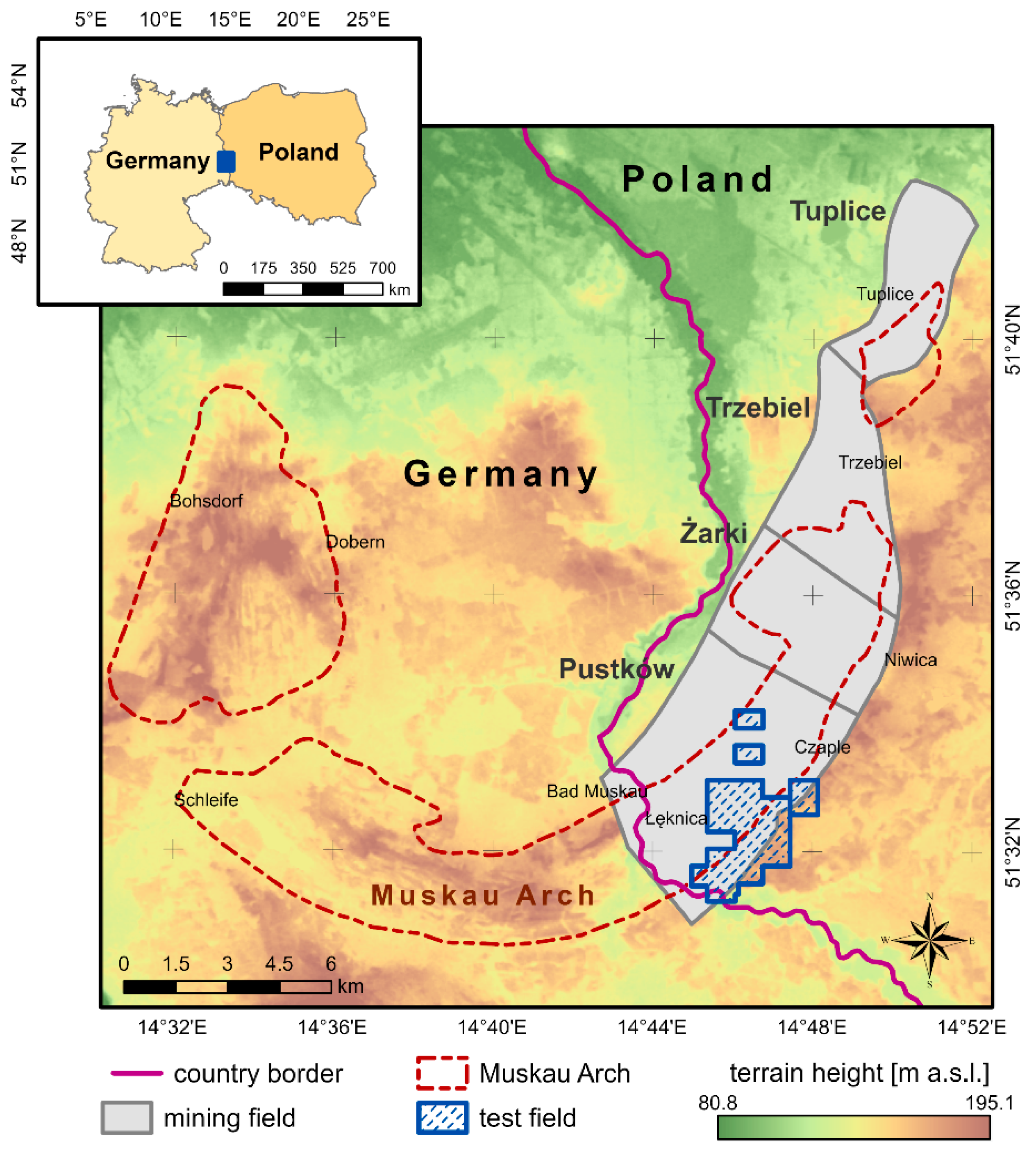
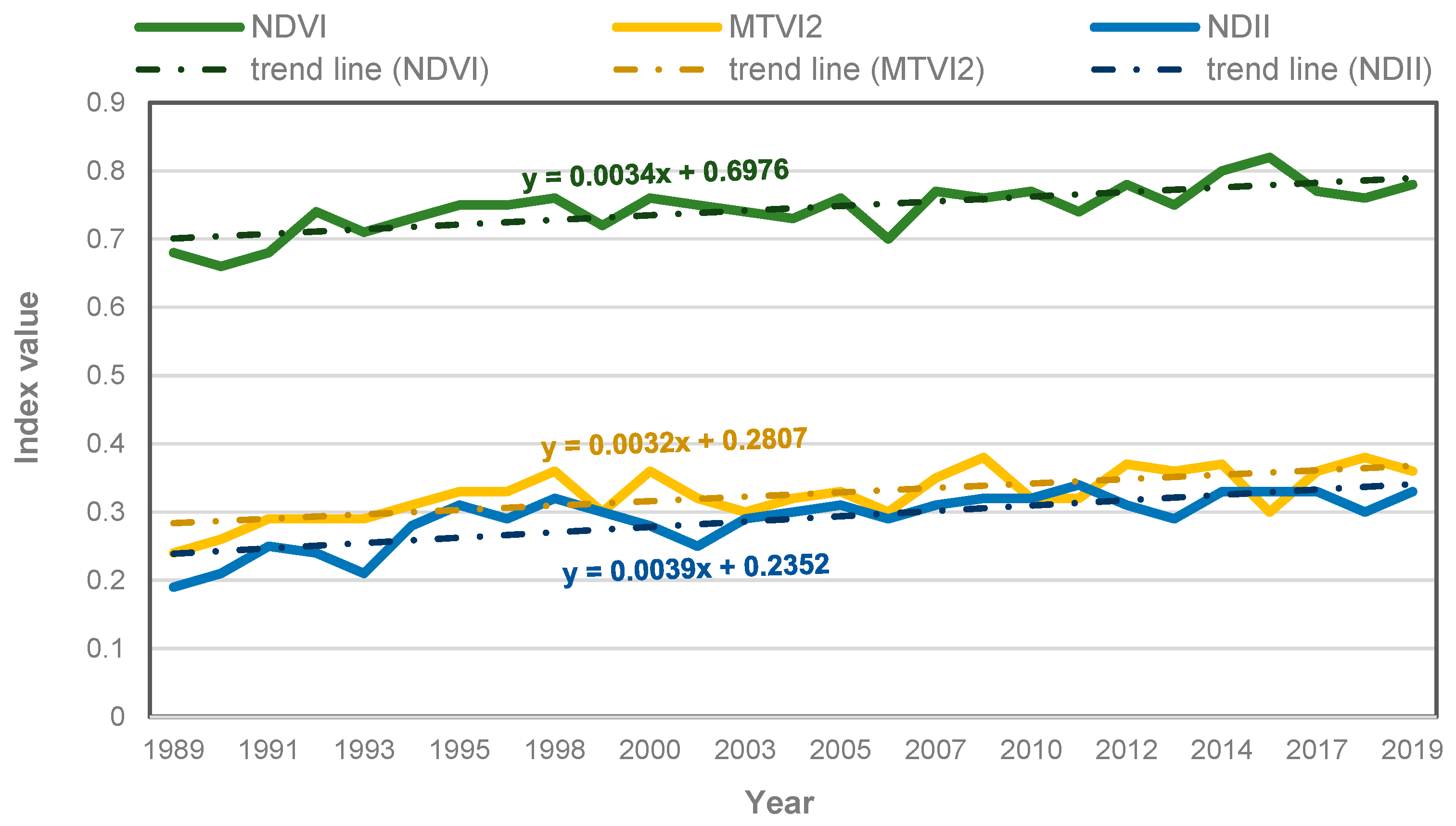
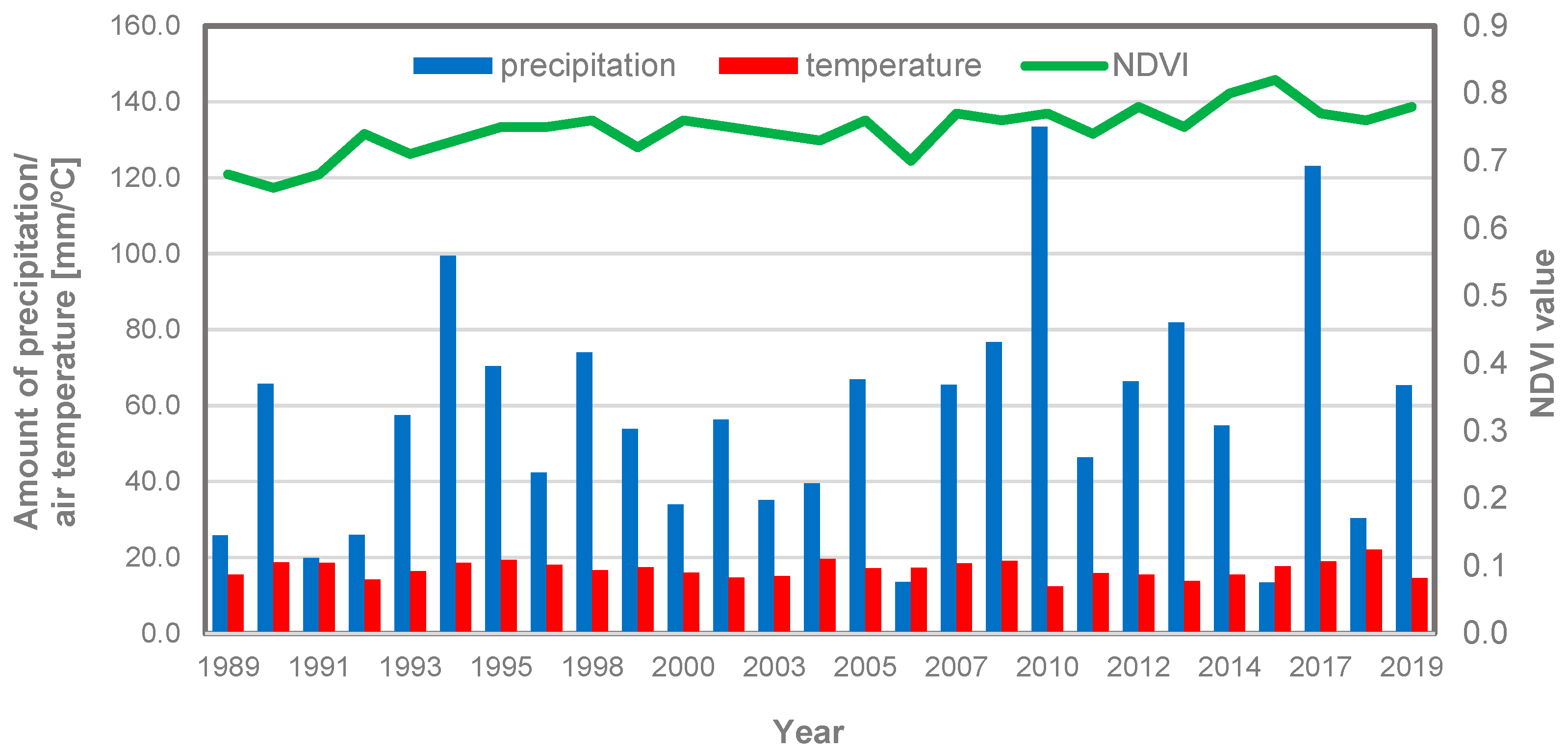
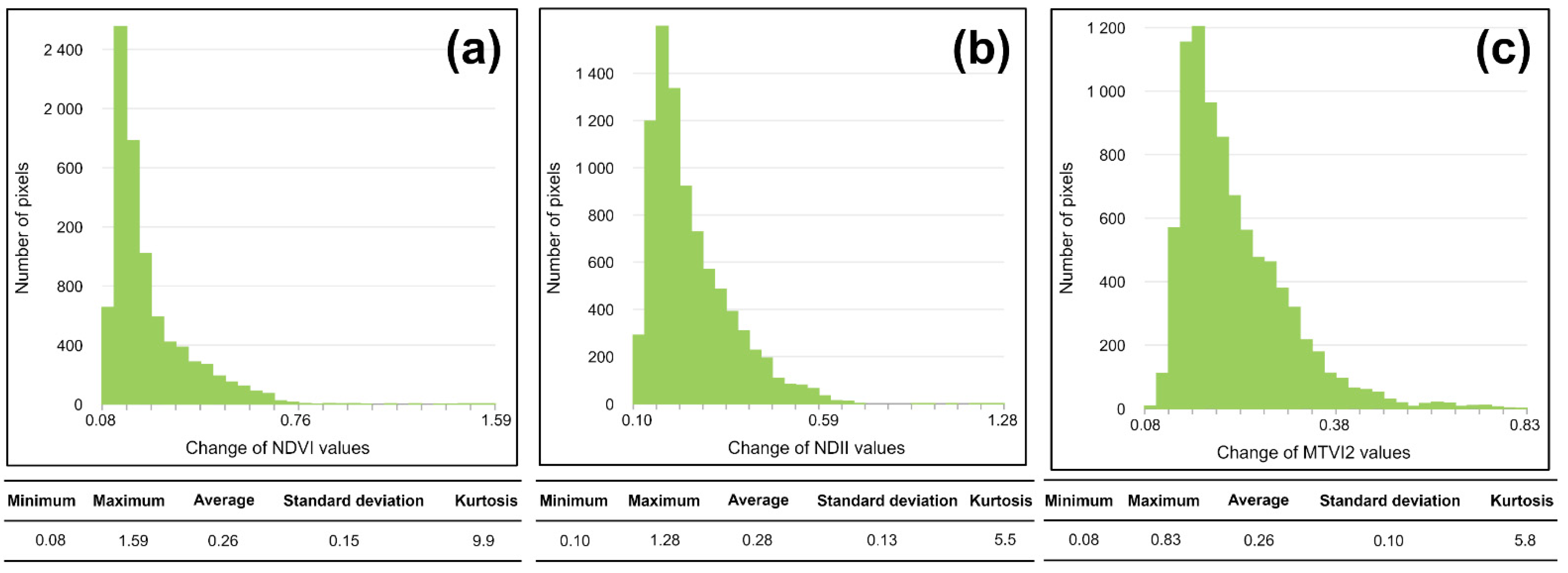


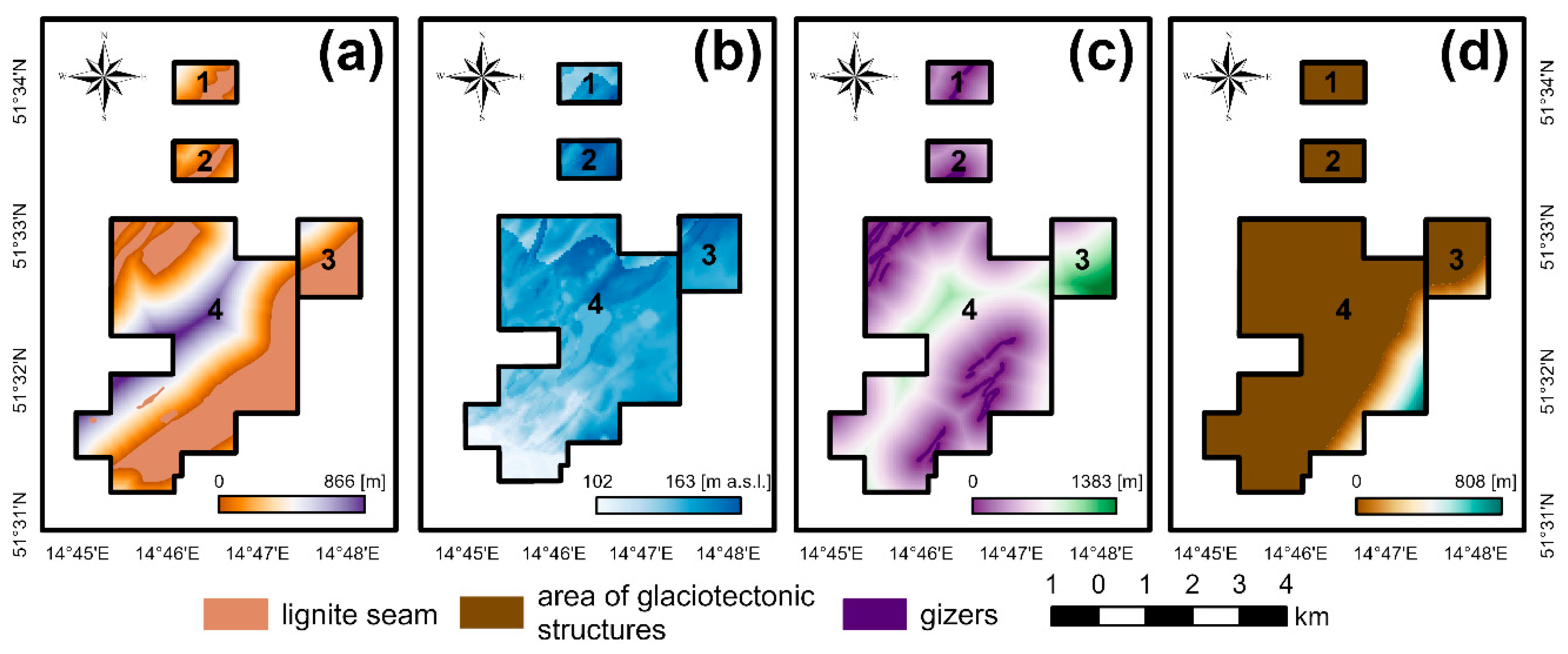
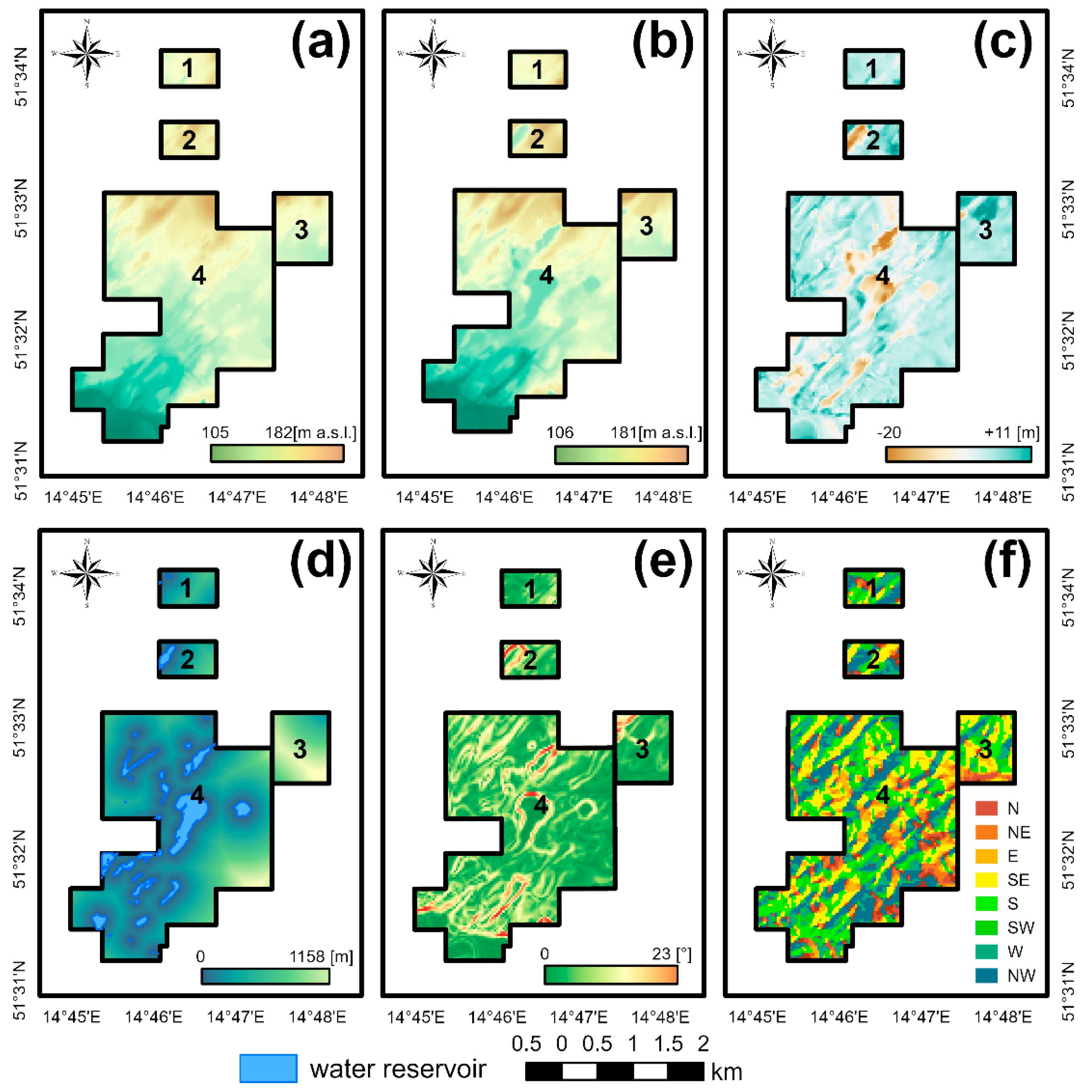


| Independent Variables | NDVI | NDII | MTVI2 | |||||||||
|---|---|---|---|---|---|---|---|---|---|---|---|---|
| Min | Max | Mean | Std | Min | Max | Mean | Std | Min | Max | Mean | Std | |
| Distance from the anthropogenic lakes | −7.98 | 0.25 | −0.05 | 0.29 | −0.35 | 0.58 | −0.01 | 0.05 | −4.04 | 1.35 | −0.03 | 0.17 |
| DEM (2020) | −4.71 | 3.02 | −0.39 | 0.24 | −3.29 | 4.74 | −0.08 | 0.60 | −9.43 | 12.20 | −0.17 | 0.99 |
| DEM of Difference (2020–1911) | −19.12 | 5.69 | −0.13 | 0.72 | −4.13 | 3.24 | −0.05 | 0.53 | −20.33 | 5.10 | −0.07 | 1.09 |
| Distance from the lignite seams | −0.72 | 0.66 | 0.00 | 0.05 | −0.49 | 0.35 | 0.00 | 0.05 | −2.27 | 0.89 | −0.01 | 0.10 |
| Distance from former open pits | −1.13 | 7.93 | 0.02 | 0.27 | −0.78 | 0.40 | 0.00 | 0.06 | −1.99 | 3.39 | 0.01 | 0.15 |
| Distance from the underground workings | −0.12 | 2.35 | 0.02 | 0.13 | −0.21 | 0.75 | 0.00 | 0.04 | −0.15 | 1.50 | 0.02 | 0.08 |
| Distance from the waste heaps | −0.14 | 0.66 | 0.01 | 0.04 | −0.20 | 0.84 | 0.01 | 0.05 | −0.58 | 1.39 | 0.00 | 0.04 |
| Distance from gizers | −0.74 | 0.50 | 0.00 | 0.07 | −0.61 | 0.41 | 0.01 | 0.05 | −0.77 | 0.32 | 0.00 | 0.05 |
| Aspect | −0.06 | 0.19 | 0.00 | 0.01 | −0.11 | 0.02 | 0.00 | 0.01 | −0.28 | 0.13 | 0.00 | 0.01 |
| Independent Variable * | The Area of Positive Influence of the Independent Variable | ||
|---|---|---|---|
| NDVI | NDII | MTVI2 | |
| DEM (2020) | the NE part of the test field no. 4 | the NE and SW parts of the test field no. 4 | the NE and SE parts of the test field no. 4 |
| DEM of Difference (2020–1911) | the NW, SW and SE parts of the test field no. 4 | the NW part of the test field no. 1 | the NW part of the test field no. 1, southern part of the test field no. 3, SW and SE parts of the test field no 4. |
| Distance from lignite seams | not identified | not identified | not identified |
| Distance from former open pits | The SE part of the test field no. 4 | not identified | the SE part of the test field no. 4 |
| Distance from underground workings | the NW part of the test field no. 4 | not identified | not identified |
| Independent Variable * | The Area of Negative Influence of the Independent Variable | ||
|---|---|---|---|
| NDVI | NDII | MTVI2 | |
| Distance from anthropogenic lakes | the NW and SE parts of the test field no. 4 | not identified | the SE part of the test field no. 4 |
| DEM (2020) | the NE and SW parts of the test field no. 3, SW and SE parts of the test field no. 4 | the NW part of the test field no. 1, SE part of the test field no. 3, eastern part of the test field no. 4 | the NW part of the test field no. 1, the southern part of the test field no. 3, eastern and SW parts of the test field no. 4 |
| DEM of Difference (2020–1911) | the NE and SE parts of the test field no. 4 | the southern part of the test field no. 3 and NE part of the test field no. 4 | the southern part of the test field no. 3 and eastern part of the test field no. 4 |
| Distance from lignite seams | not identified | not identified | the SE part of the test field no. 4 |
| Distance from former open pits | not identified | not identified | the SE part of the test field no. 4 |
Disclaimer/Publisher’s Note: The statements, opinions and data contained in all publications are solely those of the individual author(s) and contributor(s) and not of MDPI and/or the editor(s). MDPI and/or the editor(s) disclaim responsibility for any injury to people or property resulting from any ideas, methods, instructions or products referred to in the content. |
© 2023 by the authors. Licensee MDPI, Basel, Switzerland. This article is an open access article distributed under the terms and conditions of the Creative Commons Attribution (CC BY) license (https://creativecommons.org/licenses/by/4.0/).
Share and Cite
Buczyńska, A.; Blachowski, J.; Bugajska-Jędraszek, N. Analysis of Post-Mining Vegetation Development Using Remote Sensing and Spatial Regression Approach: A Case Study of Former Babina Mine (Western Poland). Remote Sens. 2023, 15, 719. https://doi.org/10.3390/rs15030719
Buczyńska A, Blachowski J, Bugajska-Jędraszek N. Analysis of Post-Mining Vegetation Development Using Remote Sensing and Spatial Regression Approach: A Case Study of Former Babina Mine (Western Poland). Remote Sensing. 2023; 15(3):719. https://doi.org/10.3390/rs15030719
Chicago/Turabian StyleBuczyńska, Anna, Jan Blachowski, and Natalia Bugajska-Jędraszek. 2023. "Analysis of Post-Mining Vegetation Development Using Remote Sensing and Spatial Regression Approach: A Case Study of Former Babina Mine (Western Poland)" Remote Sensing 15, no. 3: 719. https://doi.org/10.3390/rs15030719
APA StyleBuczyńska, A., Blachowski, J., & Bugajska-Jędraszek, N. (2023). Analysis of Post-Mining Vegetation Development Using Remote Sensing and Spatial Regression Approach: A Case Study of Former Babina Mine (Western Poland). Remote Sensing, 15(3), 719. https://doi.org/10.3390/rs15030719







